Saturday, June 18, 2005
Silvered Æ antoninianus, Gallienus, Siscia, Göbl 1411ff
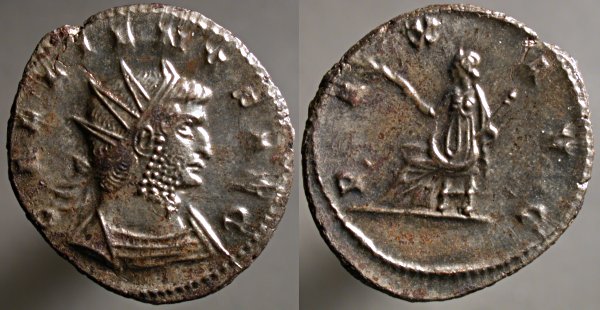
GALLIENVS AVG, Radiate cuirassed bust right | PAX AVG, Pax seated left holding branch left and transverse scepter.
As much as I try to avoid too many upgrades to coins in the collection, I couldn't resist replacing this with today's coin. I'm pleased with it.
Friday, June 17, 2005
Æ21, Parium in Mysia, Gallienus, unknown
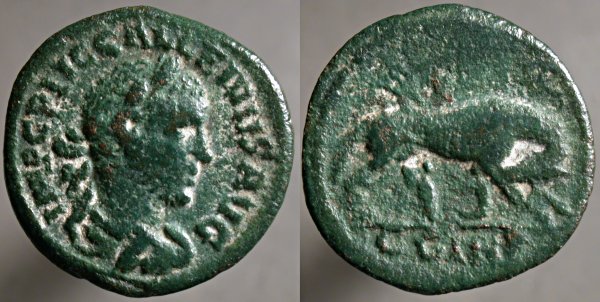
IMP C P IIC GALLENVS AVG, Laureate draped bust right | She-wolf standing right, head down looking at twins while they suckle. C G I H P in exergue.
A bit less crude than coins of Parium at this time generally are, even with the misspelled obverse, I don't find this in any catalog I own, though similar coins, with even less literate legends, are well-documented.
The reverse is very similar to one used at Alexandria Troas, but I think the resemblance is superficial and not evidence of some common mint resource.
Thursday, June 16, 2005
Silvered Æ antoninianus, Gallienus, Antioch, Göbl 1628g
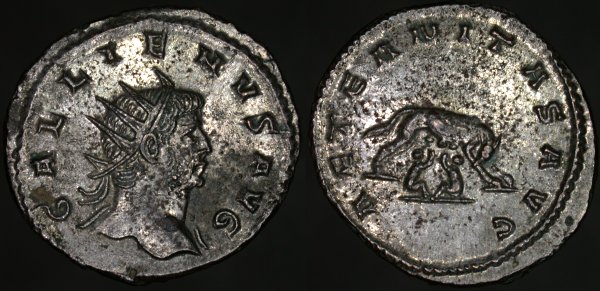
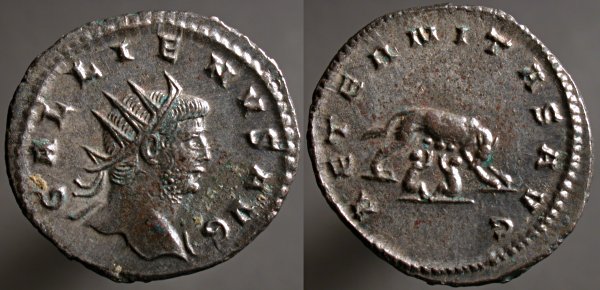
GALLIENVS AVG, Radiate head right, slight drapery on both shoulders | AETERNITAS AVG, She-wolf standing right, suckling twins.
Göbl attests a single example of this coin, so I was pleased to acquire one, but a bit frustrated trying to photograph it. Deterioration of some of the silvered surface produces some very dark areas, but areas that haven't deteriorated are still very reflective. Ultimately I decided that I knew no single way to light it effectively, and that two different pictures would be easier.
Wednesday, June 15, 2005
AR denarius, D. Junius Silanus, 91 BCE, Rome, Crawford 337/3
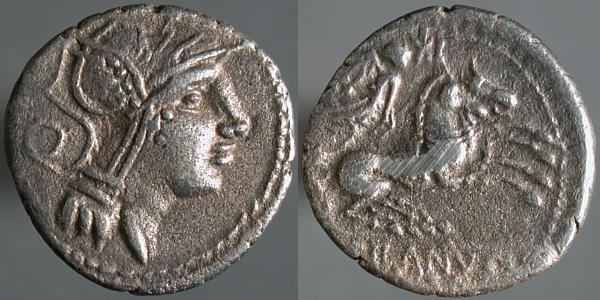
Helmeted head of Roma right. Q behind. | Victory in biga with horses rearing. XI above, [D. ]SILANVS[ L F] / [ROMA] in exergue.
Silanus was a fairly common name used by the Junia gens, but it's not quite clear who this D. Junius Silanus was. He doesn't seem to have achieved anything of great note.
A position as one of the "Tres Viri/Quattuor Viri Aere Argento Auro Flando Feriundo", the annual magistrates of the Roman mint, a significant step in the cursus honorum, but not one that guaranteed future success.
Still, this late in the Republic, rising too high could attract to much attention, attention of the wrong kind. Perhaps our Silanus didn't wish to try to overcome the force that was brought against those thought to be ambitious for primacy over their fellows. Perhaps he did try and was quickly brought low by that force.
Or, the state of medicine being what it was, perhaps some fever kept it from ever being an issue.
Tuesday, June 14, 2005
Æ29, Aphrodisias in Caria, Gallienus, MacDonald Type 227...
O263a/R540?
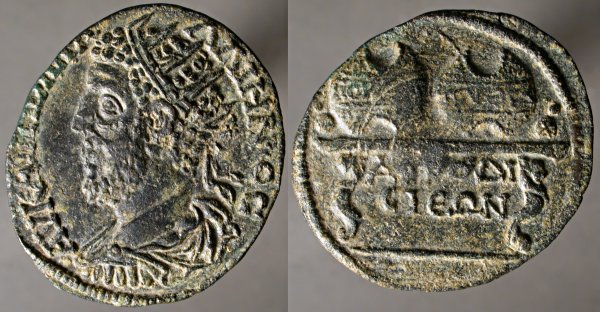
AV K[AI ΠO ΛI ΓA]ΛΛIHNOC, Radiate draped cuirassed bust left, seen from behind | Agonistic table with two prize crowns and two purses, the left crown marked ΓOP[ΔIA], the right ΠVΘIA. Between the two legs of the table, which are composed of the hind leg and head of a griffin, AΦPOΔIC / IEΩN.
Aphrodisias is today Geyre in Turkey and home to some ancient statues, ruins, and a flourishing tourism industry.
The crowns on the ornate table are prizes in the Capitoline Pythian games started to honor Gordian III and Attalos II Philadelphus, king of Pergamon. (This sort of meaningless diplomatic display was as familiar then as it is today.) Varieties of this reverse with the left-most crown marked ΚΑΠΕΤΩΛ, for Jupiter Capitolinus, are commomer than those marked ΓΟΡΔΙΑ, for Gordian. Of these last MacDonald only shows one certain example, but this reverse looks, to me, much like R540, a reverse that he depicts only with that crown worn to illegibility, except that his plate clearly shows part of a legend (ΟΙΚ[]Ν[]) on the front edge of the table which isn't apparent here.

AV K[AI ΠO ΛI ΓA]ΛΛIHNOC, Radiate draped cuirassed bust left, seen from behind | Agonistic table with two prize crowns and two purses, the left crown marked ΓOP[ΔIA], the right ΠVΘIA. Between the two legs of the table, which are composed of the hind leg and head of a griffin, AΦPOΔIC / IEΩN.
Aphrodisias is today Geyre in Turkey and home to some ancient statues, ruins, and a flourishing tourism industry.
The crowns on the ornate table are prizes in the Capitoline Pythian games started to honor Gordian III and Attalos II Philadelphus, king of Pergamon. (This sort of meaningless diplomatic display was as familiar then as it is today.) Varieties of this reverse with the left-most crown marked ΚΑΠΕΤΩΛ, for Jupiter Capitolinus, are commomer than those marked ΓΟΡΔΙΑ, for Gordian. Of these last MacDonald only shows one certain example, but this reverse looks, to me, much like R540, a reverse that he depicts only with that crown worn to illegibility, except that his plate clearly shows part of a legend (ΟΙΚ[]Ν[]) on the front edge of the table which isn't apparent here.
Monday, June 13, 2005
R.I.P.
Dave Surber, on the Moneta-L list, reports the June 12 death of Dr. Henry Clay Lindgren, psychologist and numismatist.
Silvered Æ antoninianus, Gallienus, Rome, Göbl 488q¹var...
(normal q in exergue)
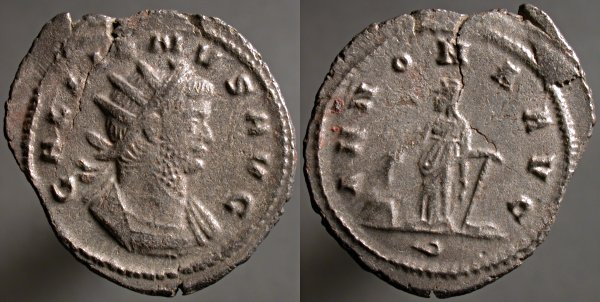
GALLIENVS AVG, Radiate cuirassed bust right | ANNONA AVG, Annona standing facing , head left, holding rudder right and ears of grain over modius left, retrograde Q in exergue.
It may seem too picky, even for a specialist collector, to pronounce this an (apparently) unpublished variant simply for the sake of one backwards letter, but I think there's sufficient support for this in Göbl's catalog itself:
(photos link to larger versions)
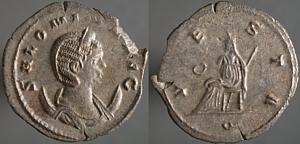
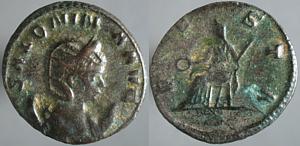
365dd(1) and 365dd(2) are distinguished only by the direction of the Q in exergue. The numbering indicates they were cataloged as varieties, rather than distinct rows in the attribution grid, which I suspect was done by Göbl's continuators to avoid having to renumber every subsequent coin.
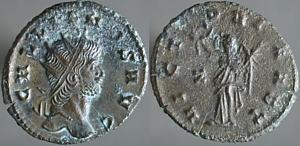
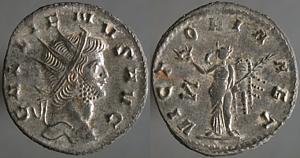
588a and 589a, distinguished only by the direction of the Z in the left field. They're in their own rows in the grid, presumably placed there by Göbl himself.
My conclusion is that if Göbl or his continuators had known of coins struck from the same die as was used for this coin, they'd have cataloged it.

GALLIENVS AVG, Radiate cuirassed bust right | ANNONA AVG, Annona standing facing , head left, holding rudder right and ears of grain over modius left, retrograde Q in exergue.
It may seem too picky, even for a specialist collector, to pronounce this an (apparently) unpublished variant simply for the sake of one backwards letter, but I think there's sufficient support for this in Göbl's catalog itself:


365dd(1) and 365dd(2) are distinguished only by the direction of the Q in exergue. The numbering indicates they were cataloged as varieties, rather than distinct rows in the attribution grid, which I suspect was done by Göbl's continuators to avoid having to renumber every subsequent coin.


588a and 589a, distinguished only by the direction of the Z in the left field. They're in their own rows in the grid, presumably placed there by Göbl himself.
My conclusion is that if Göbl or his continuators had known of coins struck from the same die as was used for this coin, they'd have cataloged it.
Sunday, June 12, 2005
Æ21, Parium in Mysia, Valerian II, SNG Copenhagen 310
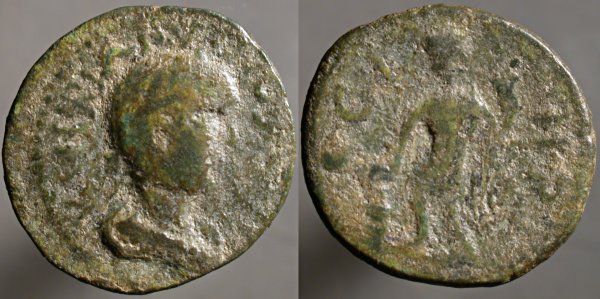
VALERIANVS NOBIL CAE, Laureate draped bust right | C G I H P, Genius standing facing, head left, holding cornucopiae right and patera over cippa left.
Unlike Berytus/Beirut, the origin of Friday's coin, Parium, where this was minted, is today the site of the village Kamares, a resort town.
The coin uses the reverse legend C G I H P, an abbreviation for the formal name of the city, Colonia Gemella Julia Hadriana Parium.
Provincial coins of the sons of Gallienus are fairly uncommon, perhaps because they died relatively early in the reign.

